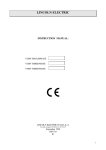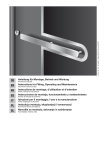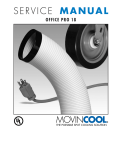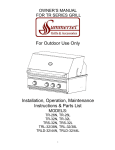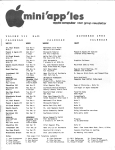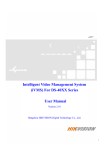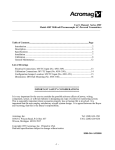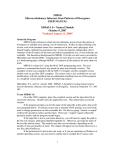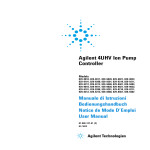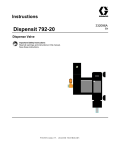Download Vacuum Ion Pump Manual Models V20 V30 V60 V110 V140 V220
Transcript
D U N I W AY S T O C K R O O M C O R P. W W W . D U N I W A Y . C O M Instruction Manual Sputter - Ion Pump Models V20, V30, V60, V110, V140 V220, V270, V400, V500 Copyright © 1998 by Duniway Stockroom Corp. 1 of 22 1305 SPACE PARK WAY MOUNTAIN VIEW, CALIFORNIA 94043 TELEPHONE: 1-650-969-8811 TOLL-FREE: 1-800-446-8811 FAX: 1-650-965-0764 EMAIL: [email protected] D U N I W AY S T O C K R O O M C O R P. W W W . D U N I W A Y . C O M Table of Contents I Technical Specifications A. B. C. D. E. F. G. page 4 Weight and Dimensions Pumping Speed Data High Voltage Supply Input Rating Vacum Flange Connection Grounding Requirements External Environmental Range Vacum Operation Range II Principle of Operation page 7 A. Overview B. Choice of Pumping Element Technology C. Typical Applications III Installation A. B. C. D. E. page 11 Preliminary Tests Mounting Requirements Grounding Requirements Connecting the High Voltage Supply Starting the Pump IV Operation/Protection page 18 A. Introduction B. Pressure Indication V Maintenance A. B. C. D. E. F. page 20 Leakage Current & Hi-Potting Leak Checking Magnet Checking Demounting the Pump Factory Maintenance High Voltage Feedthrough 2 of 22 1305 SPACE PARK WAY MOUNTAIN VIEW, CALIFORNIA 94043 TELEPHONE: 1-650-969-8811 TOLL-FREE: 1-800-446-8811 FAX: 1-650-965-0764 EMAIL: [email protected] D U N I W AY S T O C K R O O M C O R P. W W W . D U N I W A Y . C O M List of Figures Table 1: Pump Dimensions and Weights page 4 Table 2: Relative Pumping Speeds Various Gases and Pump Element Technologies page 4 Table 3: Model Number Cross Reference page 6 Figure 1: Relative Pumping Speed for Nitrogen Diode, Triode and Noble Diode page 5 Figure 2: Diode Sputter-Ion Pump Configuration (Models V20, V30, V60, V140, V270 and V500) page 7 Figure 3: Triode Sputter-Ion Pump Configuration (Models V110, V220, and V400) page 9 Figure 4: Photograph of V20, V30 and V60 Ion Pumps page 10 Figure 5: Photographs of V110/V140, V220/V270 and V400/V500 page 10 Figure 6: Feedthrough with “Garter Spring “ and Grounded Connector Shell page 12 Figure 7: Sputter-Ion Control Unit Voltage and Power vs. Current IPC-0062 page 17 Figure 8: Sputter-Ion Control Unit Voltage and Power vs. Current IPC-0066 page 17 Figure 9: Sputter-Ion Pump Current vs. Pressure V20, V30 and V60 Ion Pumps page 19 Figure 10: Sputter - Ion Pump Current vs. Pressure V110/140, V220/270 and V400/500 Ion Pumps page 19 Figure 11: Magnet Orientations for Various Pump Configurations page 21 3 of 22 1305 SPACE PARK WAY MOUNTAIN VIEW, CALIFORNIA 94043 TELEPHONE: 1-650-969-8811 TOLL-FREE: 1-800-446-8811 FAX: 1-650-965-0764 EMAIL: [email protected] D U N I W AY S T O C K R O O M C O R P. W W W . D U N I W A Y . C O M I Technical Specifications A. Weight and Dimensions Pump Speed Flange OD Height Width Depth Weight (l/s) Inches (mm) Inches (mm) Inches (mm) Inches (mm) Pounds (Kg) 20 2.75 (70) 7.35 (186) 8.40 (214) 5.20 (132) 27 (12.3) 30 4.50 (114) 8.56 (218) 9.50 (242) 5.20 (132) 34 (15.4) 60 6.00 (152) 11.44 (290) 14.00 (353) 5.20 (132) 55 (25.0) 110/140 8.00 (203) 21.75 (552) 12.25 (312) 8.50 (216) 165 (75.0) 220/270 8.00 (203) 21.75 (552) 12.25 (312) 10.62 (270) 250 (113.6) 400/500 8.00 (203) 21.75 (552) 20.00 (508) 10.62 (270) 400 (181.8) Table 1: Pump Dimensions and Weights B. Pumping Speed Data Gas Species Diode Triode Noble Diode Nitrogen 100 70 85 Oxygen 70 70 70 Hydrogen 220 140 160 Argon 1-2 20 20 Helium 10 20 15 Carbon Dioxide 100 70 85 Water Vapor 100 70 85 Table 2: Relative Pumping Speeds Various Gases and Pump Element Technologies 4 of 22 1305 SPACE PARK WAY MOUNTAIN VIEW, CALIFORNIA 94043 TELEPHONE: 1-650-969-8811 TOLL-FREE: 1-800-446-8811 FAX: 1-650-965-0764 EMAIL: [email protected] D U N I W AY S T O C K R O O M C O R P. W W W . D U N I W A Y . C O M Relative Pumping Speeds - Nitrogen 120 80 60 Pumping Speed - l/s 100 Diode Noble Diode Triode 40 20 1.00E-10 1.00E-09 1.00E-08 1.00E-07 1.00E-06 1.00E-05 0 1.00E-04 Pressure - Torr Figure 1: Relative Pumping Speed for Nitrogen Diode, Triode and Noble Diode C. High Voltage Supply Input Rating It is important to operate the pump with the proper control unit. Diode and Noble Diode ion pumps are rated to operate with a control unit that supplies +5,500 volts DC. Triode ion pumps are designed to operate with -5,500 volts DC. Power and voltage versus current curves are shown in Figures 6 and 7. D. Vacum Flange Connection The vacuum flange connection from the pump to the vacuum system is a ConFlat type flange. Outer diameter is shown in Table 1 for the different models. The pump comes sealed with a cover flange, a copper gasket and 6 stainless steel screw/nut sets. Connection to the vacuum system requires a new copper gasket. Extra flanges, nuts, bolts, washers and gaskets are available from Duniway Stockroom Corp.. 5 of 22 1305 SPACE PARK WAY MOUNTAIN VIEW, CALIFORNIA 94043 TELEPHONE: 1-650-969-8811 TOLL-FREE: 1-800-446-8811 FAX: 1-650-965-0764 EMAIL: [email protected] D U N I W AY S T O C K R O O M C O R P. W W W . D U N I W A Y . C O M E. Grounding Requirements Due to the hazardous nature of the high voltage used to operate this pump, it is important that proper grounding be present at all times during pump operation. Dual grounding means are provided: The first grounding means is through the high voltage connector outer cable shield and shell which are positively connected, via the “garter spring” on the pump high voltage feed through, to the pump body when installed. See Figure 5 above. The second grounding means is through a separate grounding cable which is connected to the case of the control unit and the grounding boss/lug on the pump case. F. External Environmental Range Operating temperature range: Maximum baking temperature: non operating, without magnet Relative Humidity: Elevation: 32oF (0oC) to 100oF (38oC) 775oF (450oC) 0% - 90% non-condensing -1000 ft (-300 meters) to +10,000 ft (+3000 meters) MSL G. Vacum Operation Range 2 x 10-3 torr (2 microns, 2 millitorr) 10-4 torr to below 10-11 torr Maximum Starting Pressure: Continuous Operating Range: Duniway Model # DuniwayOrder # Varian Equivalent Element Type Pump Speed (Nitrogen) DSC Control Unit V20D V20T V20N V30D V30T V30N V60D V60T V60N V110T V140D V140N V220T V270D V270N V400T V500D V500N VA-20-DD/M VA-20-TR/M VA-20-ND/M VA-30-DD/M VA-30-TR/M VA-30-ND/M VA-60-DD/M VA-60-TR/M VA-60-ND/M VA-110-TR/M VA-140-DD/M VA-140-ND/M VA-220-TR/M VA-270-DD/M VA-270-ND/M VA-400-TR/M VA-500-DD/M VA-500-ND/M 911-5036 911-5030 911-5050 911-5037 911-5032 NA 911-5038 911-5034 NA 912-7006 912-7000 NA 912-7014 912-7008 NA 912-7022 912-7016 NA Diode Triode Noble Diode Diode Triode Noble Diode Diode Triode Noble Diode Triode Diode Noble Diode Triode Diode Noble Diode Triode Diode Noble Diode 20 14 17 30 21 25 60 42 50 110 140 120 220 270 230 400 500 425 IPC-0062 IPC-0062 IPC-0062 IPC-0062 IPC-0062 IPC-0062 IPC-0062 IPC-0062 IPC-0062 IPC-0066 IPC-0066 IPC-0066 IPC-0066 IPC-0066 IPC-0066 IPC-0066 IPC-0066 IPC-0066 Table 3: Model Number Cross Reference 6 of 22 1305 SPACE PARK WAY MOUNTAIN VIEW, CALIFORNIA 94043 TELEPHONE: 1-650-969-8811 TOLL-FREE: 1-800-446-8811 FAX: 1-650-965-0764 EMAIL: [email protected] D U N I W AY S T O C K R O O M C O R P. W W W . D U N I W A Y . C O M II Principle of Operation A. Overview The sputter-ion pump operates on the principle of the Penning cold-cathode discharge. In this type of pump, a combination of magnetic and electric fields sustains a discharge in a structure such as shown in Figure 1. In the most common configuration, an array of cylindrical anode cells is placed between parallel cathode plates made of titanium. A positive voltage of between 3000 volts and 7000 volts is applied to the anode and a magnetic field of between 1000 and 2000 gauss is applied parallel to axis of the anode cells. At pressures below approximately a millitorr, a cloud of spiralling electrons is captured inside the anode cells. These electrons collide with residual gas molecules to form positive ions. The gas molecules, being heavier and of opposite charge than the electrons, accelerate out of the anode cell toward the cathode plates. When they reach the cathode, the ions release their energy, causing: 1. Some of the titanium atoms to be released (sputtering). This chemically active material is deposited onto surfaces nearby. It acts as a getter until saturated. 2. Secondary electrons to be released, which get incorporated into sustaining the discharge inside the anode cells. 3. Chemical reaction with the titanium, if the gas ion is an active, and/or burial in the cathode for both active and noble gases. Figure 2: Diode Sputter-Ion Pump Configuration (Models V20, V30, V60, V140, V270 and V500) 7 of 22 1305 SPACE PARK WAY MOUNTAIN VIEW, CALIFORNIA 94043 TELEPHONE: 1-650-969-8811 TOLL-FREE: 1-800-446-8811 FAX: 1-650-965-0764 EMAIL: [email protected] D U N I W AY S T O C K R O O M C O R P. W W W . D U N I W A Y . C O M B. Choice of Pumping Element Technology 1. Diode In the description of Figure 1 above the most common configuration of sputter-ion pumps, the diode, is described. Both cathodes are made of titanium and the structure is simple and rugged. For most applications, where active and/or residual gases comprise the main load on the pump, this configuration works well. This applies to Nitrogen, Oxygen, Water Vapor, Carbon Dioxide and like chemically active gases. In the case of pumping some specific gases, however, variations of the structure are useful. For noble gases, such as argon, either as the main gas load or as the result of sustained air leaks (argon comprises approximately 1% of air), the diode pump can develop problems. Since argon is chemically neutral, it is pumped by burial only. After prolonged operation, some of the previously buried argon gets re-emitted due to the sputtering action. The pressure rise causes additional sputtering, which causes additional argon to be re-emitted, etc. and the pressure rises more and more rapidly, up to the point where the pressure reaches about 10-4 torr. At this point the electrical discharge changes mode into a more diffuse form, the argon gets slowly pumped into other areas of the pump and the pressure slowly falls over a few minutes. At a certain point, the discharge shifts back into the confined Penning mode, and the pressure falls rapidly to the base pressure of the system. This behavior, called “argon instability”, continues in a periodic fashion, with a period which increases as the size of argon load decreases. To stabilize this behavior, the balance of sputtering/burial/re-emission must be shifted. This is accomplished by two variations: the triode and the differential pump. 2. Triode In the triode configuration of sputter-ion pumps, two basic changes are made: a. The voltage polarity is modified, so that the anode array is grounded and the cathode plates are operated at a negative high voltage. b. The cathode is constructed of strips of titanium instead of a flat plate. This combination of changes shifts the balance of sputtering, ion burial, re-emission and net noble gas pumping to the point where stable pumping of air and modest loads of noble gases can be maintained. Several variations of this structure, called triode, StarCell, etc., have been used, with more or less success in stabilizing noble gas pumping. A typical triode configuration is shown in Figure 2. 8 of 22 1305 SPACE PARK WAY MOUNTAIN VIEW, CALIFORNIA 94043 TELEPHONE: 1-650-969-8811 TOLL-FREE: 1-800-446-8811 FAX: 1-650-965-0764 EMAIL: [email protected] D U N I W AY S T O C K R O O M C O R P. W W W . D U N I W A Y . C O M Figure 3: Triode Sputter-Ion Pump Configuration (Models V110, V220, and V400) 3. Noble Diode/Differential Another variation for stable pumping of noble gases, is called the noble diode or differential ion pump. In this diode configuration, instead of two cathodes, both made of titanium, one of the cathodes is made of tantalum. Tantalum is a heavier element (atomic weight 181 versus titanium at 48), and thus sputters at a slower rate than titanium. This differential sputtering again shifts the areas of burial and net build-up of sputtered material to an extent which results in stable pumping of noble gases. 4. Hydrogen The pumping of sustained loads of hydrogen requires another variation in the cathode structure of the diode configuration. Hydrogen has a high affinity for titanium, which combined with its small diameter, causes the hydrogen to be captured and diffused into the bulk of the cathode material. In order to accommodate larger quantities of hydrogen, the cathode material is made thicker in special hydrogen pumping elements. C. Typical Applications Because of their simplicity, cleanliness and trouble free operation at low pressures, sputterion pumps are especially suited for a number of applications. These include, electron beam devices, ion beam devices, particle accelerators, high power vacuum tubes, semiconductor processing equipment, mass spectrometers, material research equipment and many others. 9 of 22 1305 SPACE PARK WAY MOUNTAIN VIEW, CALIFORNIA 94043 TELEPHONE: 1-650-969-8811 TOLL-FREE: 1-800-446-8811 FAX: 1-650-965-0764 EMAIL: [email protected] D U N I W AY S T O C K R O O M C O R P. W W W . D U N I W A Y . C O M Figure 4: Photograph of V20, V30 and V60 Ion Pumps Figure 5: Photographs of V110/V140, V220/V270 and V400/V500 10 of 22 1305 SPACE PARK WAY MOUNTAIN VIEW, CALIFORNIA 94043 TELEPHONE: 1-650-969-8811 TOLL-FREE: 1-800-446-8811 FAX: 1-650-965-0764 EMAIL: [email protected] D U N I W AY S T O C K R O O M C O R P. W W W . D U N I W A Y . C O M III Installation A. Preliminary Tests The sputter-ion pump arrives well protected in a package and under vacuum. After carefully unpacking the pump, inspect it for signs of shipping damage. If any shipping damage is suspected, immediately contact Duniway Stockroom Corp. Before opening the flange with the copper pinchoff, it is advisable to check to be sure that it is still under vacuum, as it was shipped. This is accomplished by properly grounding the pump case (see above), connecting the high voltage connector and applying the operating voltage to the pump. The magnet must be in place. Normally, there will be a brief surge of current, of less than 100 micro-amperes, due to pressure rise during shipment, which will dissipate rapidly. Within a brief time, the current should fall to the microamp level, corresponding to pressure of less than1x10-8 torr. If a high current is observed, or if the current does not fall rapidly to less than a few microamps, or if no current at all is observed, the pump is probably not under vacuum. Contact Duniway Stockroom immediately. B. Mounting Requirements The system should have a mounting flange which is the same as the pump flange: See Table 1 for flange diameters for each pump model. A new copper gasket and the set of bolts and nuts from the original closure flange are required. See Table 1 for pump dimensions for clearance requirements. C. Grounding Requirements Due to the hazardous nature of the high voltage used to operate this pump, it is important that proper grounding be present at all times during pump operation. Dual grounding means are provided: The first grounding means is through the high voltage cable shield and connector shell which are connected to the control unit chassis and pump body when installed. Be sure that the “garter spring” around the pump high voltage feedthrough is in place when the high voltage connector is installed. See Figure 6 below for a view of the high voltage feedthrough and connector shell. The second grounding means is through a separate grounding cable which is connected to the case of the control unit and the grounding boss/lug on the pump case. 11 of 22 1305 SPACE PARK WAY MOUNTAIN VIEW, CALIFORNIA 94043 TELEPHONE: 1-650-969-8811 TOLL-FREE: 1-800-446-8811 FAX: 1-650-965-0764 EMAIL: [email protected] D U N I W AY S T O C K R O O M C O R P. W W W . D U N I W A Y . C O M Figure 6: Feedthrough with “Garter Spring “ and Grounded Connector Shell D. Connecting the High Voltage Supply Caution: The voltages utilized by sputter-ion pumps are hazardous and can cause severe injury or death if proper procedures are not followed. The high voltage connection is provided via a coaxial cable, which has MS type connector on the control unit end and a male banana plug surrounded by a ceramic insulator and grounded metal shell on the pump end. The outer shield of the coaxial cable is grounded at both ends for safety reasons. See Figure 5 for a sketch of the pump-end connection. When connecting the high voltage control unit to the pump, the first step is to be sure that the high voltage control unit is OFF. Then, firmly attach the control unit end of the cable to the control unit. Next, verify that the “garter spring” grounding spring is in place around the groove between the insulator and metal portion of the feedthrough. Then, slip the cylindrical connector shell over the high voltage feed through, being sure that the male banana plug of the connector engages the female receptacle of the high voltage feedthrough and that the cylindrical shell of the connector engages the “garter spring” for grounding purposes. When properly engaged, the connector is firmly in place with little room for movement. 12 of 22 1305 SPACE PARK WAY MOUNTAIN VIEW, CALIFORNIA 94043 TELEPHONE: 1-650-969-8811 TOLL-FREE: 1-800-446-8811 FAX: 1-650-965-0764 EMAIL: [email protected] D U N I W AY S T O C K R O O M C O R P. W W W . D U N I W A Y . C O M E. Starting the Pump 1. Introduction Sputter-ion pumps have many advantages in simplicity, cleanliness and reliability for high and ultra-high vacuum systems. The transition from the roughing pressure to independent operation at high vacuum is referred to as “starting”. With some attention to preparation and operation during starting, this transition can be made smoothly and with a minimum of problems. 2. Preparation Before beginning the operation of a sputter ion pump, it is advisable to consider some system and safety issues. If these issues are taken into account, both personal and equipment convenience will be assured. First of all, in order to take maximum advantage of the pumping speed available from the sputter-ion pump, the conductance, or access for gas flow should be maximized. This means decreasing the length and increasing the diameter of the tubing connecting the sputter-ion pump to the system. Second, cleanliness should be observed in handling and preparing both the system and the sputter-ion pump. Exposure to oils, water vapor or dust can significantly add to the gas load, both during starting and continued operation. Even fingerprints can be harmful in contributing to gas loads. Sputter-ion pumps do not deteriorate just by being stored at atmospheric pressure, if they are kept clean. Aluminum foil or a plastic cover on the inlet flange during storage will keep out dust, dirt and debris. Finally, for personal safety, always establish a definite electrical grounding connection from the sputter-pump case to control unit ground. Sputter-ion pumps operate with high voltages and current levels which can be fatal if accidental contact is made. By assuring proper grounding of the pump, personal safety is greatly improved, and proper operation of control unit overload circuits is provided. 3. Control Unit/Power Supply Each sputter-ion pump requires a control unit of an appropriate voltage level, polarity and current capacity. These parameters are best determined by consulting the User Manual for the sputter-ion pump and/or the control unit. If the original documents are not available, the manufacturer’s catalog may have the information. In any case, you can call Duniway Stockroom, where a comprehensive listing of this information is maintained. (“Varian and Perkin Elmer Ion Pump Control Units, 1961-1992, 1992-1996.”) In general, the larger the pump rating in liters per second, the higher the required current capacity. Also, triode configurations (triode or StarCell) require negative voltage polarity while diode configurations (diode, noble diode, DI) require positive voltage polarity. 13 of 22 1305 SPACE PARK WAY MOUNTAIN VIEW, CALIFORNIA 94043 TELEPHONE: 1-650-969-8811 TOLL-FREE: 1-800-446-8811 FAX: 1-650-965-0764 EMAIL: [email protected] D U N I W AY S T O C K R O O M C O R P. W W W . D U N I W A Y . C O M Voltage is usually rated as “open circuit voltage”, that is the voltage with no current load on the control unit. Current is usually rated as “short circuit current”, that is the current drawn by the power supply when the output is shorted to ground. Examples of voltage and power versus current for typical sputter-ion pump control units are shown below in Figures 7 and 8. A Duniway Stockroom Corporation IPC-0062 for pump models V20. V30 and V60, is shown in Figure 7 and the Duniway Stockroom Corporation IPC-0066 for pump models V110/140, V220/270 and V400/500 is shown in Figure 8. In the plots in Figure 7 and 8, the voltage is represented on the vertical axis by the bars, the power is represented on the vertical axis by the line plot and the current is represented on the horizontal axis. The voltage rating of the power supply is shown by the maximum voltage plot at the upper left of the graph, or approximately 5,300 volts for the IPC-0062 in Figure 7; the current rating of the power supply is shown by the point in the lower right of the plot where the power curve intercepts the lower axis, or 0.17 amps (170 ma) for the IPC-0062; and the power rating is shown by the top of the power curve, or 220 watts for the IPC-0062. The equivalent ratings for the IPC-0066 can be seen in Figure 8. The product of voltage and current at any point in the process gives the power going into the sputter-ion pump. This information is displayed as plot of power versus current. This plot has a power maximum near the middle range of the current capacity. This maximum is called the “power hill”, because as the pump current moves either up or down (the same as the pressure moving up or down) it must climb this “power hill”. Increasing power means increasing heat to be dissipated, which normally means an increasing gas load due to outgassing. As we will see below (5. Starting), the heating that takes place due to power dissipation has an effect on the starting of the pump. Sputter-ion pump current is proportional to pressure, especially in the pressure ranges below 10 torr. This relationship is expressed by the equation: I/P=constant. Thus, at lower pressures, pump current can be used as an indicator of the pressure. An example of the relationship between sputter-ion pump current and pressure is shown attached as Figure 9; in this case for diode pumps of 20, 30 and 60 liters per second; the control unit is a Duniway Stockroom IPC-0062. The slope of the I/P curve for the 30 l/s pump shown is 500 amps per torr. (Calculated by choosing a typical point on the curve, say 1 milliamp at 2x10-6 torr, and dividing the current at that point by the pressure at that point). -5 The I vs. P relationship for pumps with speeds of 110/140 l/s, 220/270 l/s, and 400/500 l/s is shown in Figure 10. 14 of 22 1305 SPACE PARK WAY MOUNTAIN VIEW, CALIFORNIA 94043 TELEPHONE: 1-650-969-8811 TOLL-FREE: 1-800-446-8811 FAX: 1-650-965-0764 EMAIL: [email protected] D U N I W AY S T O C K R O O M C O R P. W W W . D U N I W A Y . C O M 4. Roughing/Trapping Sputter-ion pumps operate by using a low pressure gas discharge called the Penning discharge. Through a combination of magnetic field and electric field, gas ions are formed and captured on active metal plates, such as titanium. The Penning discharge only operates at pressures below approximately 10-3 torr, so the pressure in the pump and vacuum system must be reduced by other means to reach that pressure range. A variety of rough vacuum pumps is available, including rotary mechanical pumps, turbomolecular pumps and sorption pumps. Since the sputter-ion pump is inherently clean and typically used in clean, ultra-high vacuum applications, it is important to use a clean technique for rough pumping. Also, the roughing pump should have a valve to isolate it from the sputter-ion pump after the starting phase, since the sputter-ion pump can operate independently on a closed system. In addition to the gases contained in the volume of the system, the main gas load at the lower pressures is represented by the water vapor that is adsorbed on all the surfaces of the system. It is a good idea to check the base pressure obtained by the roughing pump to assure that the pump is reaching a pressure adequately low for sputter-ion pump starting. A properly calibrated thermocouple gauge will do the job, and a pressure below 10 millitorr indicates adequate roughing pump performance. Lower pressure before starting will generally lead to quicker results. The cleanest roughing pump technology is the sorption pump, which uses ultra-high surface area materials such as molecular sieve, which are chilled to liquid nitrogen temperatures. Water vapor, oxygen, nitrogen, argon and most organic vapors are pumped by sorption pumps, thus reducing the pressure to a few millitorr. For small systems a single stage sorption pump is sufficient to reach the starting pressure for sputter-ion pumps; for larger systems a sequenced, two stage sorption pump is recommended. Prior to using a sorption pump, it is important to remove the previously absorbed gases, particularly water vapor, by baking the pump. Rotary mechanical pumps, which use oil-sealed vanes, can also be used for rough pumping; however, an efficient trap must be provided between the mechanical pump and the sputter-ion pump. Either a liquid nitrogen trap or a molecular sieve trap can be used to keep the mechanical pump oil from migrating into the sputter-ion pumped system. In addition, the trap will help remove water vapor, the major gas load during the later stages of rough pumping. Mechanical pumps are not efficient at removing water vapor, since it just gets recycled through the oil on each rotation of the pump rotor. Another good alternative for rough pumping is the turbomolecular pump. This pumping technology is clean and provides a better pumping speed and lower roughing pressure than other alternatives. 15 of 22 1305 SPACE PARK WAY MOUNTAIN VIEW, CALIFORNIA 94043 TELEPHONE: 1-650-969-8811 TOLL-FREE: 1-800-446-8811 FAX: 1-650-965-0764 EMAIL: [email protected] D U N I W AY S T O C K R O O M C O R P. W W W . D U N I W A Y . C O M 5. Starting When the roughing pressure falls below 10 millitorr, the sputter-ion starting process can begin. To review the precautions, be sure that the pump is properly grounded, that the control unit voltage polarity and power rating are matched to the pump being started. Verify that the control unit “Start-Protect” switch is set to the “Start” position, and that the “Meter Range” switch is set to “Voltage”. Now turn on the “Power” switch. Immediately after turning on the power switch, observe the voltage reading on the meter. In the starting mode, the voltage should be in the 300-1000 volt range, and then gradually rise as the pump starts. (If the voltage reading is either at zero or at the open circuit rating of the control unit when the pump is turned on during starting, immediately turn the control unit off, because there is either an electrical short in the pump or an open circuit which must be found and corrected before proceeding.) Next, turn the meter switch to the highest current scale and verify that the current is near the appropriate (near short circuit current) for the control unit. Return the meter range switch to the “Voltage” position to monitor the operation of the pump. When it appears that the roughing system has reached its base pressure, close the valve between the roughing system and the sputter-ion pump and observe the results on the “Voltage” scale of the control unit. If the voltage falls, indicating a rising current (rising pressure), reopen the roughing valve. If the voltage increases or remains the same, leave the roughing valve closed. NOTE: With a sputter-ion pump, a modest rise in pressure is normal during the initial starting phase. This is caused by heating of the pump components by the dissipated power and normally precedes operation in the normal mode. Some heating during starting is beneficial because it causes out-gassing of components which will not have to take place during later stages of the system pump down. Excessive heating due to prolonged high pressure operation or a mismatched control unit can damage a pump. Operation in the start mode should always be monitored. The electrical discharge in a sputter-ion pump gives off a blue/purple glow due to the electron-gas ionization process taking place. At starting pressures, above 10-4 torr, the discharge occurs throughout the pump; in some cases it can extend into the system itself. If the presence of this discharge in the system is a problem, a stainless steel, electrically grounded screen can be placed across the mouth of the pump. As the sputter-ion pump starts, the discharge confines itself to the area within the pump elements, and gradually becomes fainter as the pressure, and thus the rate of ionization, falls. 16 of 22 1305 SPACE PARK WAY MOUNTAIN VIEW, CALIFORNIA 94043 TELEPHONE: 1-650-969-8811 TOLL-FREE: 1-800-446-8811 FAX: 1-650-965-0764 EMAIL: [email protected] D U N I W AY S T O C K R O O M C O R P. W W W . D U N I W A Y . C O M Voltage & Power vs. Current 6000 Voltage - Volts 250 Power -Watts 200 4000 150 Voltage Power 100 2000 50 0 0 0 20 30 50 70 80 100 120 130 150 170 180 200 Current Figure 7: Sputter-Ion Control Unit Voltage and Power vs. Current IPC-0062 IP C -0 0 6 6 T rio d e P o w e r/Vo lta g e v s . C u rre n t (A mp s ) 6000 800 700 5000 600 4000 500 3000 400 V oltage (V olts ) P ower (W atts ) 300 2000 200 1000 100 0 0 0 0.1 0.2 0.3 0.4 0.5 0.6 0.7 0.8 Figure 8: Sputter-Ion Control Unit Voltage and Power vs. Current IPC-0066 17 of 22 1305 SPACE PARK WAY MOUNTAIN VIEW, CALIFORNIA 94043 TELEPHONE: 1-650-969-8811 TOLL-FREE: 1-800-446-8811 FAX: 1-650-965-0764 EMAIL: [email protected] D U N I W AY S T O C K R O O M C O R P. W W W . D U N I W A Y . C O M IV Operation/Protection A. Introduction After the sputter-ion pump starts, as indicated by the voltage rising toward the open-circuit rating and current falling to below about 25% of the rated value on the control unit meter, normal operation can commence. In normal operation, the roughing pump valve is closed and the “Start/Protect” switch on the control unit is placed in the “Protect” position. The pump is now protected against a pressure rise above approximately 0.5 mTorr while unattended. Should such a pressure rise occur due to a leak or other failure, the control unit will automatically turn off after a brief delay. This protects both the pump and control unit against excessive current and heat conditions. During normal operation, pump current is proportional to pressure over a wide operating range. This is illustrated in the typical current vs. pressure curves shown below in Figures 9 and 10. By knowing the current and using the correct curve for that pump and control unit, the pressure can be calculated. In addition, most control units have a “Pressure” scale, which is a logarithmic scale from below 10-9 torr to above 10-4 torr. Also, a recorder and control signal, with a range from 0 to 100 mV, is normally available for monitoring the pump pressure. B. Pressure Indication As discussed above, sputter-ion pump current is proportional to pressure over the operating range. The graphs in Figures 9 and 10 below show typical plots of Ion Pump Current vs. Pressure for a variety of pump sizes. For example, for a 30 liter per second pump with a current indication of 1 ma, the pressure would be about 2x10-6 torr. Caution should be used in using ion pump current to indicate pressure, especially at low pressures, due to potential leakage current, as discussed below in “Maintenance”. 18 of 22 1305 SPACE PARK WAY MOUNTAIN VIEW, CALIFORNIA 94043 TELEPHONE: 1-650-969-8811 TOLL-FREE: 1-800-446-8811 FAX: 1-650-965-0764 EMAIL: [email protected] D U N I W AY S T O C K R O O M C O R P. W W W . D U N I W A Y . C O M Ion Pump Current vs. Pressure Pressure - Torr 1.00E-09 1.00E-08 1.00E-07 1.00E-06 1.00E-05 1.00E-04 8 l/s 100 20 l/s 10 30 l/s 60 l/s 0.1 0.01 0.001 0.0001 Current - Amps 1 Figure 9: Sputter-Ion Pump Current vs. Pressure V20, V30 and V60 Ion Pumps Ion Pump Current vs. Pressure Pressure - Torr 1.00E-09 1.00E-08 1.00E-07 1.00E-06 1.00E-05 1.00E-04 1000 400/500 l/s 220/270 l/s 100 110/140 l/s 1 0.1 Current - mA 10 0.01 Figure 10: Sputter - Ion Pump Current vs. Pressure V110/140, V220/270 and V400/500 Ion Pumps 19 of 22 1305 SPACE PARK WAY MOUNTAIN VIEW, CALIFORNIA 94043 TELEPHONE: 1-650-969-8811 TOLL-FREE: 1-800-446-8811 FAX: 1-650-965-0764 EMAIL: [email protected] D U N I W AY S T O C K R O O M C O R P. W W W . D U N I W A Y . C O M V Maintenance A. Leakage Current & Hi-Potting After prolonged operation, which generates quantities of sputtered material inside the pump, it is possible that current leakage, not related to pump pressure, may develop in the pump. There are two types of leakage: “Resistive Leakage” and “Field Emission Leakage”. (In both cases, such leakage can be confirmed by removing the pump magnets, which should not substantially change the leakage current.) Resistive Leakage is due to resistive coatings or short circuits of insulating elements in the pump. The presence of this leakage can be detected by using a simple ohm-meter or multi meter on the ohm or resistance scale. When resistive leakage occurs, pumping action is usually reduced or stopped, and the pump or pump elements must be rebuilt. See Section IV-E below for factory maintenance. Field Emission Leakage is due to electron release from small points or flakes in the pump, at the high voltages inside the pump. This problem does not effect the pumping action of the pump, however it may be annoying if the pump current is used as an indication of the pressure in the system. In order to reduce or eliminate field emission leakage, it is possible to apply an over voltage, a process known as “hi-potting”. Since field emission current grows exponentially with voltage, the application of higher than normal voltage can cause enough current to flow to melt the sharp points and reduce the leakage to an acceptable level. A Hi-Pot unit with voltages of 12-15 KV AC at a few milliamps is usually adequate to reduce the field emission leakage to an acceptable level. For more information on this procedure, call Duniway Stockroom Corporation. CAUTION: Extreme caution must be excersized when performing such an operation due to the hazardous nature of the voltages involved. Proper insulation and grounding must be supplied in order to avoid injury to personnel and damage to equipment. B. Leak Checking If prolonged operation, especially after baking of the system, does not result in appropriately low pressures, it is possible that there is a leak in the system. Some level of leak checking can be performed by observing the ion pump current while probing the exterior of the system with a probe gas such as helium. When the probe gas enters the system through a leak, it will cause a pump current fluctuation, related to the difference in leak rate for different diameter atoms and the difference in ionization potential of the probe gas in the ion pump discharge. More sensitivity may be obtained by using a strip chart recorder or computer display to record the pump current. 20 of 22 1305 SPACE PARK WAY MOUNTAIN VIEW, CALIFORNIA 94043 TELEPHONE: 1-650-969-8811 TOLL-FREE: 1-800-446-8811 FAX: 1-650-965-0764 EMAIL: [email protected] D U N I W AY S T O C K R O O M C O R P. W W W . D U N I W A Y . C O M C. Magnet Checking If the sputter ion pump does not seem to be operating with its normal pumping speed, it is possible that there may be a problem with magnet field strength or magnet installation. The following illustration shows proper magnet installation for a variety of pump configurations. Following the illustration is a discussion of procedures for checking magnet installation. Figure 11: Magnet Orientations for Various Pump Configurations 1. All magnets, including the Earth, have a North pole and a South pole. A simple compass can be used to determine the polarity of a magnet segment, however, readings should be made away from iron pole pieces. 2. Like poles (N-N or S-S) repel each other and unlike poles (N-S or S-N) attract each other. 3. In an Ion Pump magnet array, the magnet sections must be arranged in a magnetic circuit; that is N-S-N-S-N-S…etc., all the way around the pump. 4. The magnetic field should be between 1000-1500 gauss for most Sputter-Ion pumps. Higher magnetic fields give somewhat higher pumping speed, especially at low pressure. 5. When assembling an Ion Pump magnet array, the magnets will tend to ‘pull’ into a correct circuit configuration and ‘push’ out of an incorrect circuit configuration. 6. In Figure 11, Example 1, (a cross section of a pump such as the VPE20 and V30 models), as long as the individual blocks on the magnet assembly are installed correctly, the orientation of the magnet assembly does not matter. 21 of 22 1305 SPACE PARK WAY MOUNTAIN VIEW, CALIFORNIA 94043 TELEPHONE: 1-650-969-8811 TOLL-FREE: 1-800-446-8811 FAX: 1-650-965-0764 EMAIL: [email protected] D U N I W AY S T O C K R O O M C O R P. W W W . D U N I W A Y . C O M 7. In Figure 11, Example 2, (a cross section of a pump such as the V60, V110/140 and V400/ 500Varian 60 l/s models), as long as the individual blocks on the magnet assembly are installed correctly, the orientation of the magnet assembly does not matter. 8. In Figure 11, Example 3, (a cross section of a pump such as a V400/500Varian 110 or 140 l/ s models), the circuit must be completed exactly as shown. If one of the magnet assemblies is installed backwards, the pump will operate with some reduction in speed, but the stray magnetic field will be excessively high, and may interfere with sensitive experiments. D. Demounting the Pump If for any reason, it becomes necessary to remove the pump from the system, be sure to take the proper precautions for personnel and equipment safety. First of all, turn the control unit to the off condition. Then, remove the high voltage connector from the pump. At this point it is a good idea to remove the magnet from the pump to reduce the weight of the pump assemble. Then make sure that the pump is properly supported before starting to remove the bolts from the connection flange. Also, it is not a good idea to let the system up to atmospheric pressure by removing the sputter-ion pump, because any loose material around the gasket may be swept into the system. Loosen slightly all the bolt/nut combinations before completely removing any of the bolts. E. Factory Maintenance If it should become necessary to perform maintenance on the pump, such as replacing the pumping elements or high voltage feedthrough, it is best to return the pump, without its magnets, to the factory for maintenance. Please call Duniway Stockroom Corporation for advice and details about sputter-ion pump maintenance and rebuilding. F. High Voltage Feedthrough The high voltage feedthrough is mounted on a mini ConFlat flange. If the feedthrough is damaged or develops leakage current during transportation, installation or prolonged use, it can be replaced in the field. Feedthroughs, gaskets and nut/bolt sets are available from Duniway Stockroom Corp. REV. 08/07/98 GD 22 of 22 1305 SPACE PARK WAY MOUNTAIN VIEW, CALIFORNIA 94043 TELEPHONE: 1-650-969-8811 TOLL-FREE: 1-800-446-8811 FAX: 1-650-965-0764 EMAIL: [email protected]























